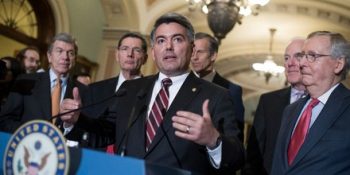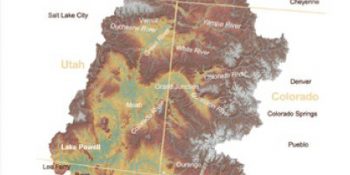The Connected Government Act Heading to the President’s Desk
WASHINGTON –The bipartisan Connected Government Act, which was introduced by Senators Cory Gardner (R-CO) and Maggie Hassan (D-NH), passed the Senate and is heading to President Trump’s desk for signature. The bipartisan measure will expand access to government services and information by requiring all new federal websites to be mobile-friendly. The Connected Government Act will support low-income Americans who rely on mobile broadband at higher rates, as well as the 80 percent of Americans who experience disabilities who use wireless technology every day.
I am thrilled that this common-sense piece of bipartisan legislation has passed the Senate and is on its way to the President’s desk. As more and more Americans rely on their mobile devices to access information and websites, it’s important the federal government has websites designed for mobile platforms. The Connected Government Act will promote transparency and bring the government into the 21st century. — Senator Gardner
“As mobile devices continue to surpass desktop use for accessing the internet, it is important that the federal government is up to speed with the latest technology that allows our people and economy to thrive,” Senator Hassan said. “I am pleased that the bipartisan Connected Government Act passed the Senate, and I urge President Trump to sign the bill into law as quickly as possible so that Granite Staters and Americans who use mobile technology, including low-income individuals and Americans who experience disabilities, can access government services, resources, and information to help them succeed.”
The Connected Government Act requires all new government websites intended to be used by the public to be mobile-friendly. The bill also requires the General Services Administration to submit a report to Congress on agency compliance with this law within 18 months of enactment. Congresswoman Robin Kelly (D-IL) and Frank Pallone (D-NJ) introduced the companion to this bill in the U.S. House of Representatives. The bill passed the U.S. House of Representatives on November 15, 2017.
See Bill text here.
Gardner Supports Potential CHIP Funding Extension
Washington, D.C. – Senator Cory Gardner (R-CO) released the below statement regarding discussions to allow the Department of Health and Human Services (HHS) to provide sufficient funding for the Children’s Health Insurance Program (CHIP) to March 31st in the Continuing Resolution (CR) that Congress will consider as soon as today. Cancellation notices for Colorado are expected to go out on December 26th if Congress does not act this week to extend funding.
I will do everything I can to ensure that the 90,000 Colorado children and pregnant mothers that utilize CHIP do not go a day without this funding. While the five year extension of CHIP funding that Senator Bennet and I continue to push in the Senate is by far the best path forward for Coloradans, absent movement on that legislation today we need to make sure funding is extended past Colorado’s deadline of January 31st. I support the inclusion of language in the must-pass CR that allows CHIP funding to continue while a long-term bipartisan agreement is worked out. — Gardner said
Senator Gardner is one of six Republicans to sponsor The Keeping Kids’ Insurance Dependable and Secure (KIDS) Act, legislation to extend CHIP funding through Fiscal Year (FY) 2022.
Colorado Fruit & Vegetable Assoc. Seeks to Fix Foreign Worker Program
The Colorado Fruit & Vegetable Growers Association (CFVGA) met last week with the staff of Sen. Michael Bennet, D-Colo., and with Sen. Cory Gardner, R-Colo., to appeal for quick legislative action to fix the current foreign worker program before the 2018 growing season. The appeal comes as Colorado fruit and vegetable growers contemplate if they can continue to grow produce given the extreme labor shortage of qualified and willing farm laborers.
Federal legislation to replace the current H2A foreign agricultural worker program, dubbed H2C, was introduced this past fall.
“Even though the current program has its shortfalls, causing Colorado growers to be less competitive in the world market, the proposed H2C program would be even worse,” said CFVGA President Robert Sakata, Sakata Farms, Brighton, Colo.
“Let’s not be under the illusion that foreign, temporary produce workers are taking American jobs,” Bruce Talbott, Talbott Mountain Gold, Palisade, Colo., told both senators. “In all the time we’ve used the H2A program, we’ve had two of 200 foreign workers not complete a contract. During that same time, we’ve had only two Americans complete contracts, and that is only because we have moved them into equipment operation jobs. Our foreign workers return year after year and are glad to have the work and what we pay them. Americans just do not want this intensive work for a time limited harvest season.”
Talbott and other growers told the senators the H2A requirements for recruiting American workers are burdensome and costly with virtually no return on their efforts and that the requirements also create untimely delays getting workers.
Ryan Fagerberg, Fagerberg Produce, Eaton, Colo., said 2017 was the first year his family’s operation used H2A. “We were happy with the results and the assurance we would have the labor we needed, but it did increase our labor costs 30-40 percent, due to the additional fees, travel costs for workers and housing requirements.”
Gardner told the growers he believes there is a better chance of enacting a good guest worker program once legislation to secure the border is put in place. He believes this action needs to be taken prior to expiration of the DACA program, which enables children brought to the United States illegally by their parents to remain and seek citizenship.
“I don’t know how much longer we will be able to continue raising fruits and vegetables, given all the regulatory requirements, and even more so this labor shortage,” said David Asbury, Rocky Mountain Pumpkin Ranch, Longmont, Colo. “The H2A program requires us to provide housing for our workers, but renting houses for such a short period is difficult, and here in Boulder County, the average cost of a home is $400,000, with prices in Boulder itself close to $1 million. That isn’t sustainable.”
CFVGA produce growers attending these meetings, told both senators that an effective guest worker program must:
- Not have a worker cap limiting the number of seasonal agricultural workers
- Change the requirements to recruit American laborers that more closely fit local availability
- Not require e-Verify, a system that has slowed hiring and flagged legal workers inaccurately until a workable seasonal guest worker is up and running and the E-verify system is accurate and reliable
- Change housing requirements to allow employers to provide housing vouchers in lieu of providing housing and making housing requirements compatible with local community availability
- Calculate the wage rate for guest workers on a more realistic basis, rather than the current adverse wage rate, taking into consideration the financial benefits of housing and transportation that are provided
- Move program to the U.S. Department of Agriculture, which understands agricultural operations, especially the time-sensitivity of agricultural labor
- Allow area farmers to share guest workers to meet ever changing operational needs
- Provide flexibility to meet the needs of shorter growing and harvest seasons of produce growers in states with seasonal production
HELP US SPREAD THE NEWS
COMMENT, Like, Follow & SHARE to get your daily dose of Tips, Tricks, News and Events! @I70Scout
RELATED NEWS CURRENT EDITION
WEATHER & TRAFFIC PUZZLES RECENT NEWS ADVERTISE WITH US








